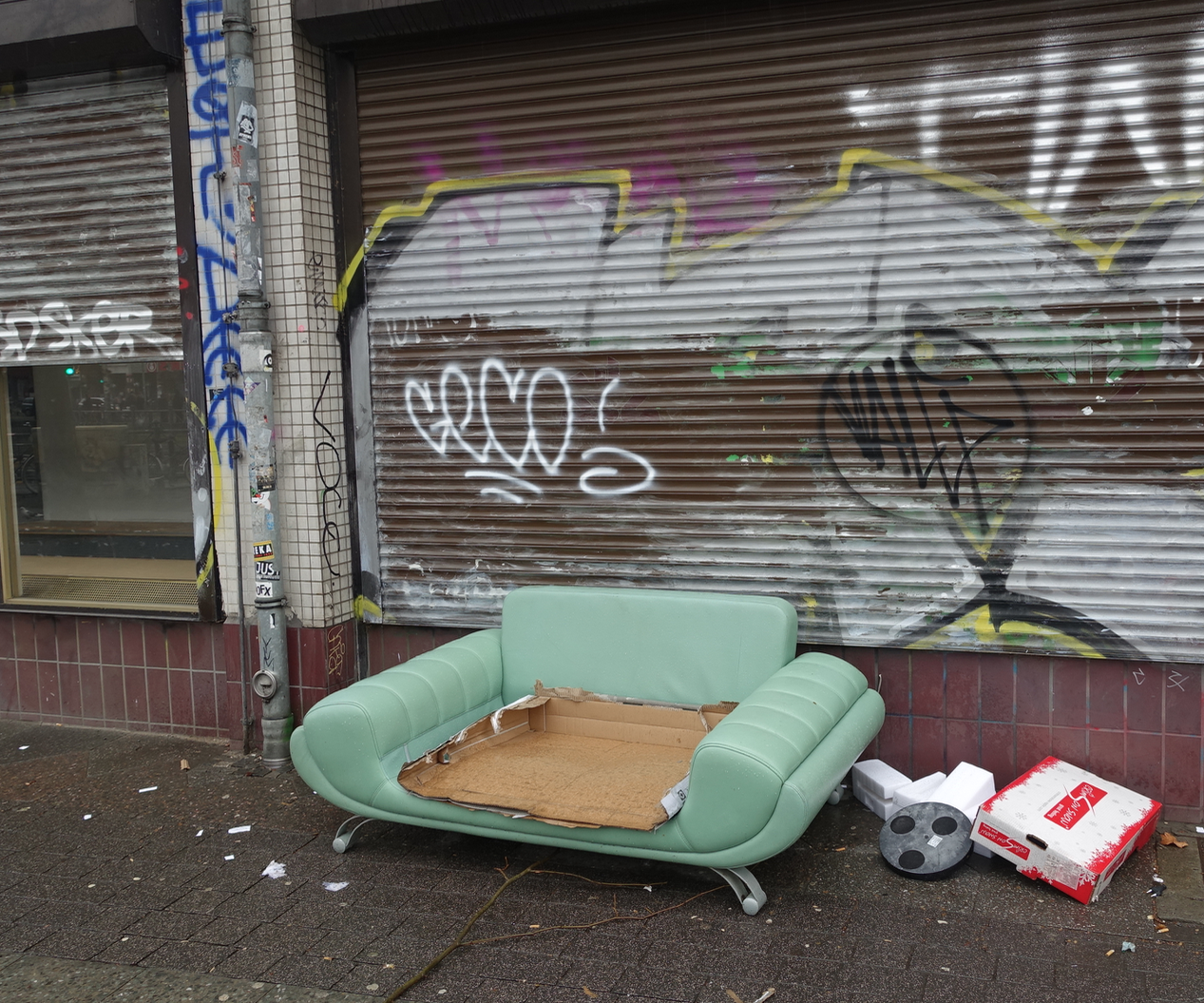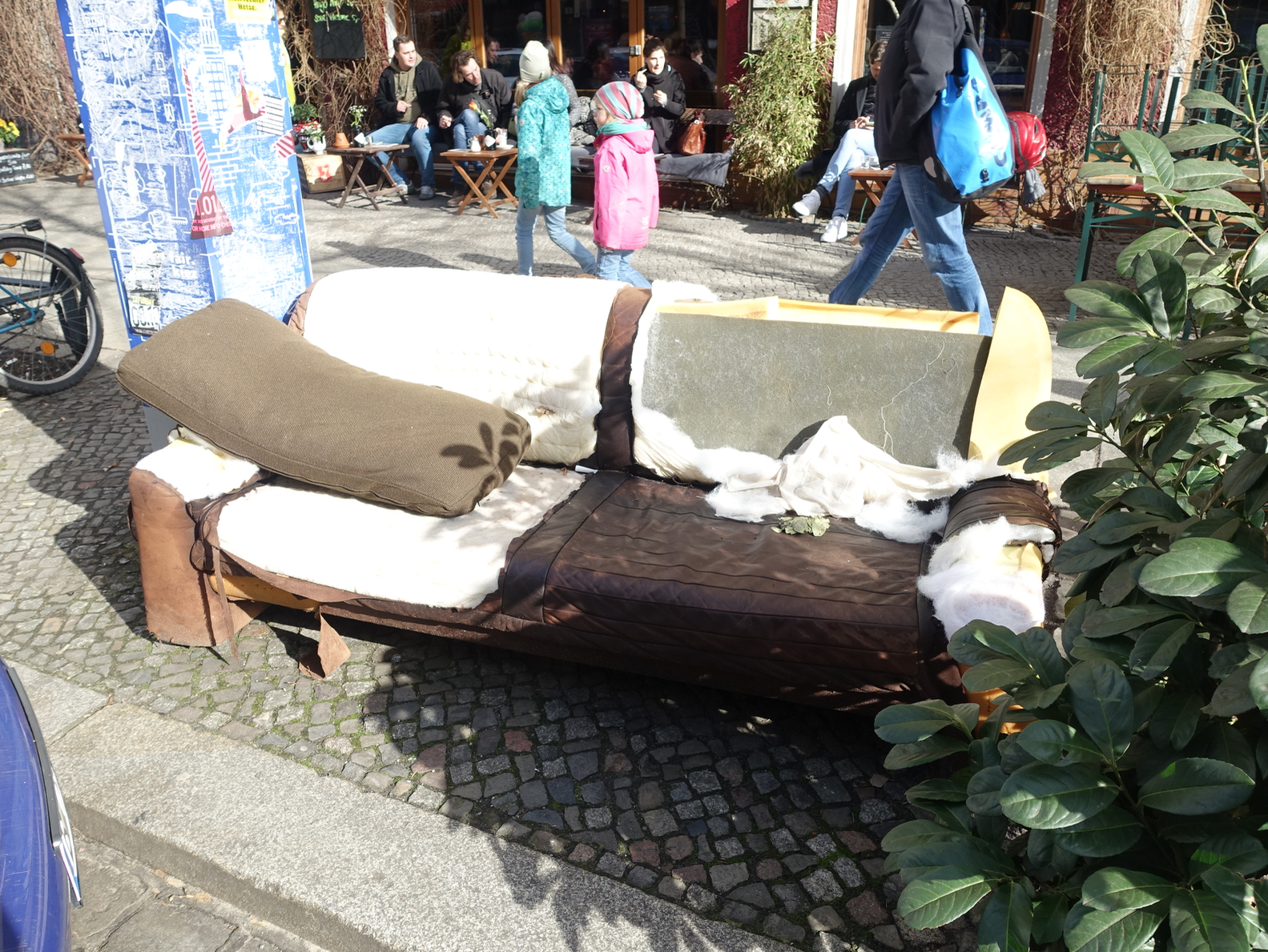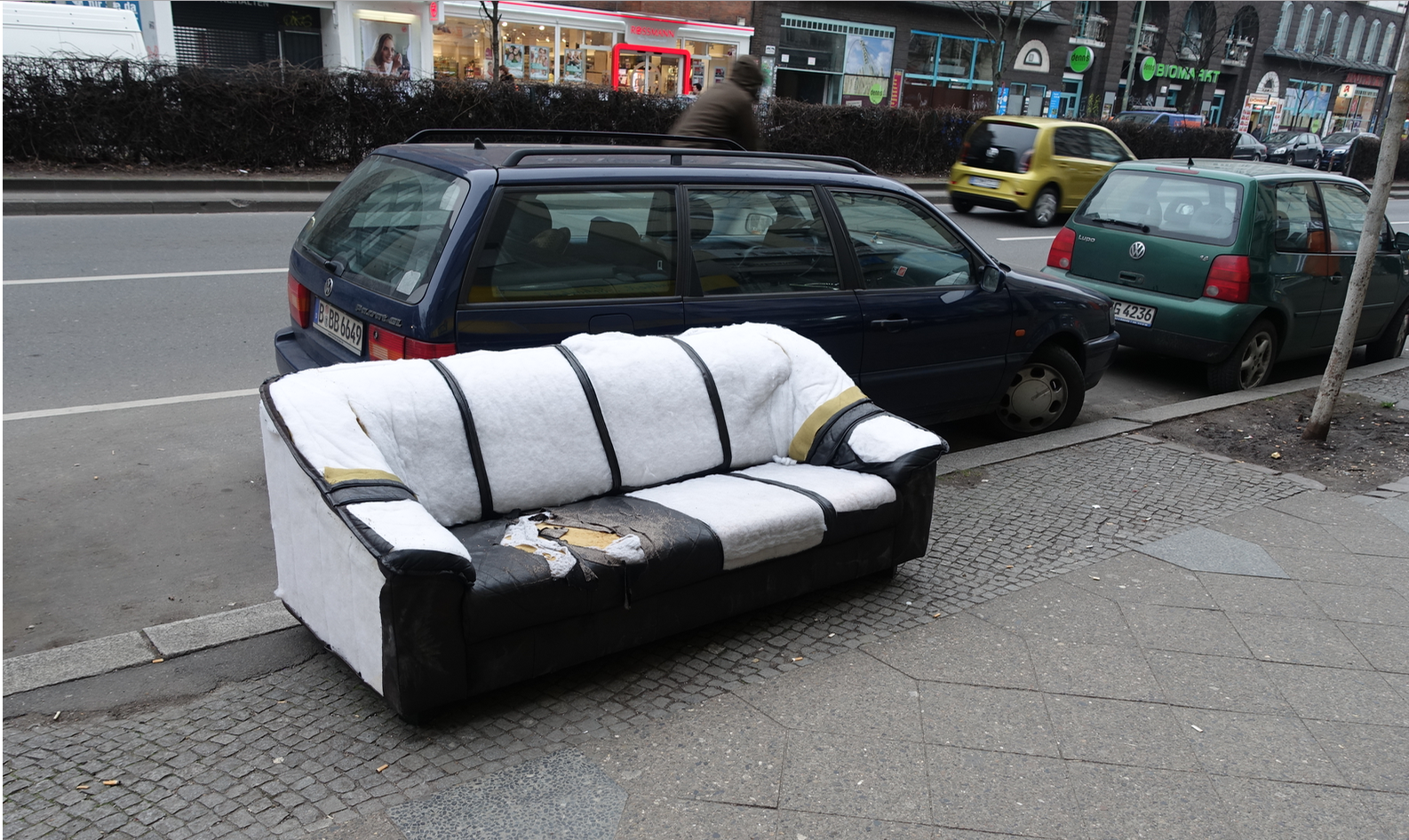Berlin is definitely quirky!
Every city has its quirks – some more than others. Yes, Austin and Portland have their fair share of quirkiness, but they are small potatoes compared to Berlin.
To prove it, I’d like to share with you some of the quirky charms we discovered in Berlin.
How about Berlin's mailpersons who ride these quirky yellow mail bikes along the sidewalk?
How about a candy floss transit station?
Or a banana slide....
Pedestrian Light Icon
What city turns its “walk” and “don’t walk” pedestrian figure into an icon that even has its own stores? Berlin. Who knew there was such a thing as a traffic psychologist? Turns out Karl Peglau, a traffic psychologist created the Ampelmannchen (little traffic light man figure) in 1961 for East Berlin’s traffic lights. The perky, playful cartoon-like character quickly become popular with locals, achieving cult status after unification as a symbol of East Berlin. Today, the red and green figures have become so popular with tourists that they have their own stores devoted only to Ampelmann-branded merchandise. Not only do they sell the usual tee shirts, pens, cups etc., but you can also purchase your own traffic signal.
Hmmmmm….could Calgary turn its +15 character into an icon for tourists?
Link: Ampelmannchen Story
S&Q Flea Markets
I am not sure if Berlin is the flea market capital of Europe, but it must be a contender. We went to a different one every weekend and each has their own sense of the strange and quirky (S&Q). While some are more upscale the ones we like the best had boxes and boxes of items for treasure hunters to explore. For me each box was like still life, each box had a story to tell if you looked carefully.
Link: Berlin Flea Market Story
Photo Booths
On our first day we noticed a photo booth in an outdoor bike rack area, thought it was strange, but didn’t give it much more thought. Until we saw many more. A local told us that photo booths are a big thing in Berlin, especially for millennials.
Turns out The Photoautomat project, founded in Berlin in 2004 and has inspired a world-wide revival of the black and white analog photo booth. Just like 60 years ago, each photo strip is analog-developed, making every piece an original that stays lightfast for 100 years.
Water Pumps
While walking the streets of Berlin, don’t be surprised if you encounter five-foot tall, green cast iron water pumps. There are 2,107 of them to be exact and they are regularly maintained. Go ahead, pump them; in fact you’re encouraged to do so to help keep the system running well. You will get cool drinkable water for your water bottle. The water is from independent emergency wells provide a backup in case the regular water supply collapses.
Cemetery Cafés
Berlin has an amazing café culture. They are literally everywhere and come in every size, shape and design. However, to find one Café Strauss in a cemetery was very cool. The serene and beautiful park-like setting in the midst of the urban environment is simply lovely. Slow living at its best – so was the coffee and cake.
Link: Cemetery Cafe Story
Pink & Purple Straws
I first encountered these strange straw-like pipes near Check Point Charlie, i.e. best-known Berlin Wall crossing from East to West Berlin during the Cold War. I was shocked that a city like Berlin would have basic infrastructure above ground. Later, I learned Berlin is built on a swamp and so construction projects must create these temporary water pipes to remove water from the site while they work until the permanent infrastructure is in place. Kudos to whoever decided to make them fun with their candy-floss like colours.
Link: Pink Pipes Story
Food Couriers
Mail couriers were a common sight in the downtowns of many cities in the ‘70s and 80s but they have largely disappeared with the advent of email. However, in Berlin food couriers are a common site with their magenta bikes and big warming oven boxes. They just add to the fun of the sidewalk ballet. Did I mention that Berlin’s mailpersons also ride big yellow or (green bikes) along the sidewalks?
Glass Igloos
The first photo I took in Berlin was of three, large domed structures side by side on the sidewalk. They looked like some old Soviet atomic energy experiment. Turns out they are called “glass igloos” and they always come in 3s. They are for recycling bottles - one for brown glass, one for green glass and clear glass. They are also highly sought after by graffiti artists and those sticker-happy millennials who still love to play with stickers.
Sidewalk Furniture
Berlin’s sidewalks are also where you toss out anything you don’t want and can’t fit into your dumpster. It is not uncommon to see an old couch or chair just sitting on the sidewalk in various stages of decay. The first chair I saw was a lovely art deco one that I would love to own; too bad it didn’t have a cushion. The second piece was a couch that I saw from across the street. It looked like the carcass of a dead animal ravaged by Berlin street wolves. It was not uncommon to sight one or two chairs/couches per day. One day there was a lovely oriental carpet in great shape.
Graffiti vs Street Art
Sure, Austin and Portland have their fair share of graffiti and street art. Austin even has a very funky abandoned building site that is an outdoor gallery for graffiti artists. But neither have entire streets and communities that are literally covered with graffiti.
In Berlin’s Fridedrichshain, Kreuzberg and Neukolin districts, there a ribbon of graffiti and art on every building along almost every street from sidewalk up to the top of the doorway.
Pretty much any façade is a canvas for art. You would never know Berlin spends the equivalent of $50M CDN per year to clean up graffiti. I saw one storeowner clean up the graffiti on his building and the next day it was back.
In the Hackescher Market area there is an entire three story building (Haus Schwarzenberg) and alley is completely covered with graffiti.
Loved this empty subway station space. It seemed like an abandoned space, with unused advertising boards that have become transformed into works of art with their multiple layers of randomly ripped posters and graffiti. It had the appearance of a contemporary art gallery.
Red Is Dead
In Berlin the bike paths are usually a dark reddish colour and they are often just part of a wide sidewalk (Berlin has the widest sidewalks I have ever seen). This makes it easy for a pedestrian to wander inadvertently over into the bike lane. We were told by a local to remember, “If you are in the red you, could easily be dead.”
At the same time, bikes also wander onto the sidewalk. It really is a free-for-all as everyone bobs and weaves like a North American football halfback. Oh, seems kids and families get to ride their bikes on the sidewalks at all times. Flaneuring as I do, I can’t believe I didn’t die.
FYI: Berlin has plans to build 10 super highways for cyclists, but I wouldn’t hold my breath. They have been planning a new airport for many years and it still isn’t open. So much for German efficiency.
Strange Playgrounds
Another early observation was that although Berlin has many children’s playgrounds, they look like they haven’t been upgraded since the ‘50s - maybe earlier. I did not find one of our Lego-like Crayola-coloured metal playgrounds anywhere in Berlin. Instead I found these strange weathered creatures that looked like something carved by indigenous people hundreds, perhaps thousands of years ago. I expect some of the animals are quite strange looking and I thought would be scary looking for children, but that didn’t seem to be the case.
What's with this howling wolf on top of a playground swing?
Cash is King
Most experienced international travellers are used to just bringing their credit cards and charging most of their expenses. It is easy and convenient. You are probably OK to use a credit card if you stay in the touristy areas of Berlin, but venture into the local areas like Kreuzberg and you will find it is cash only culture.
At the Galleries Lafayette (posh department store) there is an ATM that dispenses gold bars weighing up to 250 grams. Berlin is a great reminder of how commerce has evolved, especially over the past 50 years.
Late Night Buses
On weekends the buses and trains provide 24-hour service, but on weekdays night buses and the Metrotram take over to providing 30-minute service. There are 11 special night buses to make sure you can get home even if you are clubbing until 4 am. The night buses combine several daytime routes to make sure that all parts of the city have late night transit service.
Beer 24/7
I think one of the biggest reasons Berlin is so popular with millennials to day is that they have over 1,000 Spatis (late night stores). These tiny stores (size of a living room) open 24/7 have about half of their space devoted to beer and wine. Not only is beer available 24/7, but it is cheap, about $1.50 CDN for .5 litres and you can drink it on the street as you wander home or to your favourite park. We even encountered many young people enjoying a beer on the trains in the evening – not sure that was legal, but nobody seems to mind.
Many of the Spatis have bench out front that allows you to just sit enjoy your beer, chat with friends or watch the sidewalk ballet. How civilized?
FYI: Berlin is also home to the world’s longest beer garden; it runs 2.2 kilometers during the annual International Beer Festival.
And There Is More
How about an abandoned airport that has been turned into a huge park not by design but by locals taking ownership? This is a part of the miniature golf course that has been created out of found objects including old plane parts.
These drums at the cashiers of a Berlin grocery store are cigarette dispensers.
What about a former ballroom dance hall, that became a night club and now is a very quirky salvage warehouse store.
Very futuristic entrance to an office building.
This has to be the quirkiest retail store signage I have seen in awhile.
Public Poetry? Found 10+ poems taped to posts along a pedestrian bridge one evening. People stopped to read them, discuss them and some even took them. What a lovely urban surprise?
Last Word
I love quirky cities! If you haven't visited Berlin (or haven't been there for a long time) you should move it to the top of your list of "places to go!"
For information on Berlin’s more traditional tourist attractions check out Caroline Mathiasen’s blog: Best things to do and see in Berlin.
If you like this blog, you will like:
Freakn Fun in Boise's Freak Alley
















































